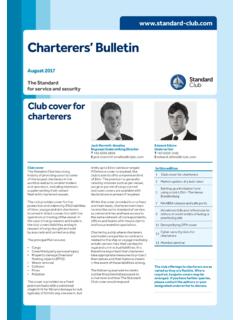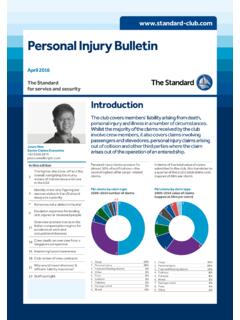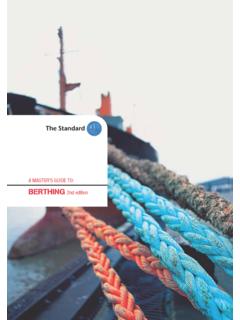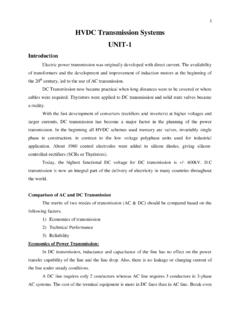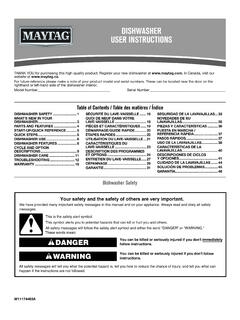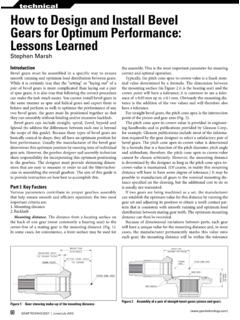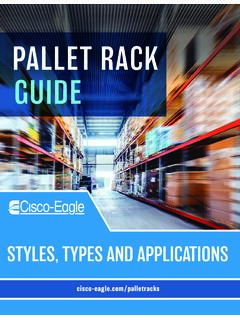Transcription of A Master’s Guide to: Hatch cover maintenance
1 | 1A Master s Guide to: Hatch cover maintenance The purpose of this Guide is to explain the key issues of Hatch cover security and to steer mariners towards active maintenance . Ensuring Hatch covers are well maintained reduces the number and cost of cargo wet damage claims. As part of the Loss Prevention department s continuing commitment to safety at sea, a number of Master s Guides have been produced. They focus on delivering best practice advice on key areas of vessel operations to avert avoidable claims and prevent accidents, casualties and incidents at sea. These guides were created by harnessing the professional knowledge of members in the Loss Prevention team who have served at sea. A Master s Guide to Hatch cover maintenance is an original Standard Club document, first produced in 2002. This revised version provides further information about the type of Hatch covers commonly used on merchant vessels, emphasizes the importance of vessel s cargoworthiness and shares loss prevention advice on preventing cargo damage resulting from Hatch cover defects.
2 Appendices are included which provide checklists for routine operation, inspections, repair and Guide sets out to promote industry best practice and was written in collaboration with Lloyd s Register, one of the world s leading providers of professional services for engineering and Yves Vandenborn, Director of Loss PreventionAbout this Guide2 | A Master s Guide to Hatch cover maintenance Contents | 301. Introduction 402. Hatch covers and their function 5 Hatch cover construction 5 Hatch cover function 503. Types of Hatch covers 6 Folding Hatch covers 6 Side-rolling Hatch covers 6 Lift-away Hatch covers 6 Single-flap Hatch covers 7 Piggy-back Hatch covers 7 Stacking Hatch covers 704. Basic advice 805. Common false beliefs about Hatch covers 1106. Leakage problems 1307. Use of sealing tape and foam fillers 1408.
3 Leak detection tests 1509. Monitoring and inspection 1710. maintenance and repair 20 maintenance of the Hatch cover structure 20 maintenance of Hatch cross joints 20 maintenance of Hatch coamings 20 maintenance of the landing pads (steel-to-steel contact surfaces) 22 maintenance of Hatch wheels and trackways 22 maintenance of rubber packing surface damage 23 maintenance of rubber packing permanent deformation 23 maintenance of rubber packing aged gaskets 23 maintenance of compression bars 24 maintenance of gasket channels 24 maintenance of the double drainage system 25 maintenance of non-return drain valves 25 maintenance of Hatch cleats and wedges 26 maintenance of locators 28 maintenance of stoppers 28 maintenance of hydraulic systems and components 28 maintenance of rubber seals on hold access doors, access hatches and ventilators 2911.
4 Heavy weather precautions 3012. Safety when working with Hatch covers 3113. Appendix 1 Procedures to open and close Hatch covers 3214. Appendix 2 Hatch cover inspection checklist 33 Checklist 1 (for single pull, side rolling, folding type Hatch covers) 33 Checklist 2 (for pontoon type Hatch covers with tarpaulin) 3415. Appendix 3 Hatch cover operation checklist 3516. Appendix 4 Sample form for ultrasonic weathertightness test of Hatch covers 36 List of figures 38 Authors 394 | A Master s Guide to Hatch cover maintenanceHatches leak for a variety of reasons, but mainly because of poor maintenance or failure to close them properly. Leaking or badly maintained Hatch covers can lead to more serious consequences than wet cargo, including flooding, accelerated corrosion or even loss of the ship.
5 It is crucial for safety at sea and protection of the environment to maintain Hatch cover weathertightness and strength. These issues are addressed in the requirements for Hatch covers are laid out in the International Convention on Load Lines, and the structural strength requirements are laid down in the SOLAS Convention and Classification Rules. Compliance with these requirements is confirmed during periodical ship surveys but may also be confirmed at any time by Port State Control Officers during an is a common misconception and a degree of confusion throughout the industry as to whether hatches are constructed to be watertight or weathertight. A watertight closure is designed to withstand water pressure from both sides of the structure, while weathertight means that regardless of the sea conditions, water will not penetrate into the ship.
6 Hatch covers are constructed to be weathertight, which means that, in any transient condition, water shall not penetrate through the covers or the double drainage system. However, it is apparent that minor leakage into a cargo hold during a Hatch cover test is often erroneously considered to be within a weathertight standard; in practice, no leakage is the standard for weathertightness. For this reason, we include guidance on procedures for conducting leak detection tests on Hatch research shows that many mariners consider hatches to be robust, monolithic structures and thereby fail to appreciate the small tolerances on panel alignment and gasket compression. In fact, Hatch covers are complex, precision-made structures that need to be handled with example, 4mm of wear on the steel-to-steel contact is enough to damage the rubber sealing gaskets beyond repair and a 5mm sag along the cross joint can cause a large gap between the compression bar and the club s condition surveys and claims analysis indicate that, in many cases, Hatch cover maintenance is not considered to be important and, when maintenance is carried out, it is often not done in line with the manufacturers guidance or industry best are often only carried out after a ship has failed a Hatch cover tightness test at the load port.
7 In such cases, maintenance is often done in haste, in an unplanned manner and without proper care. Proper maintenance and repair requires a systematic approach, but often crew cut corners in an effort to pass the tightness test as soon as possible, without giving proper regard to the quality of IntroductionThe most common cause of cargo wet damage claims on dry cargo ships is attributed to leaking Hatch covers. | 502. Hatch covers and their functionHatch covers on bulk carriers have two basic functions: in open position, they provide access to the holds for loading /discharging cargo; and in closed position, they prevent water ingress by sealing the hatchway in a weathertight condition, so that there is no leakage into the cargo hold in any sea cover constructionTypically, Hatch covers are lightweight steel grillages, either of open or closed box-type construction.
8 Modern design methods using finite element technology enable more efficient material distribution, which results in lighter (thinner) structures. Construction from high-tensile steel results in even thinner plate being used. For this reason, these lightweight structures must be handled with care . Prevention of corrosion is essential as safety margins are 1: Hatch cover constructionHatch cover functionHatch covers provide a primary structural and weathertight barrier to prevent water ingress into cargo holds. Although Hatch covers might look big and heavy, they are sensitive to the life of the ship, Hatch covers are subjected to the various forces caused by the ship s movement, wave accelerations, and load and stress factors (such as racking and sheering forces, bending moments and hogging/sagging). Rigorous inspection, regular maintenance and prompt repair of damaged covers, including securing and supports, are essential to ensure they: maintain sufficient strength to resist green seas in extreme weather maintain a barrier against ingress of water during normal seagoing weather to maintain Hatch covers correctly can lead to physical loss of a cover in extreme weather as well as hold flooding and possible foundering.
9 Minor leakages can cause cargo damage and, if they occur over a prolonged period, damage to the ship s internal structure. Long-term structural decline can lead to structural collapse and total | A Master s Guide to Hatch cover maintenanceFolding Hatch coversFolding Hatch covers are commonly used on general cargo ships, multipurpose vessels or smaller bulk carriers, such as handysize, handymax and supramax vessel types. They consist of two (or more) panels, which are connected by hinges to form a folding pair. In many cases, the Hatch cover comprises two folding pairs. One pair is stowed at the aft end of the Hatch and the other pair is stowed at the forward end. The folding pair is operated by hydraulic cylinders acting directly on the end hinge arms, which are connected at stools on the deck. When the cylinders push the end panel up from the closed position, the cover folds and the second panel, fitted with wheels, rolls on rails to a stowage position.
10 The panels are usually secured in the open position by semi-automatic locking devices interacting with the wheel Types of Hatch coversFigure 2: Folding Hatch coverFigure 3: Multi-folding Hatch coversSide-rolling Hatch coversSide-rolling Hatch covers are commonly used on the large bulk carriers, such as panamax and capesize vessel types. They consist of two panels per Hatch , with each rolling sideways on a pair of transverse ramps. This minimises the obstacles to be considered by the shore crane or other loading /unloading device operator when loading and 4: Side-rolling Hatch coversLift-away Hatch coversLift-away Hatch covers are commonly used on containerships and multipurpose vessels to facilitate quick and flexible cargo-handling operations. Lift-away panels are handled with a spreader using either shoreside container cranes or the vessel s own cranes.


